Early Australian Military Uniform

From a thesis by John Farquhar McMahon available from the Tasmanian Museum and Art Gallery #S1978.28.
According to Gwen Squires (authoress ‘Buttons. A Guide for Collectors’ published 1972) all British regiments were numbered in 1751. From 1767 these numbers, in either Arabic or Roman numerals, were used on the uniform buttons; for officers until 1881 and for other ranks until 1871. However, the New South Wales Corps was an exception, as indeed it was an exceptional corps. Their buttons were plain.
Again, according to Gwen Squires; before 1809 officers’ buttons were flat one piece but the style changed becoming more convex. Eventually this required the back of the button to be filled. After 1830 silver was changed to gilt for uniform lace and buttons. ‘Other ranks’ buttons were made of lead or pewter until 1855, then brass was used.
The NSW Corps existed from 1789-1800, after which the Corps, having returned to Britain, were reformed as the 102nd Regiment of Foot. It would be expected from this dating that flat silvered pewter buttons would have been used on the officers coatees* at first, and more convex buttons later on. If the buttons above are original (this is not always the case with historical uniforms) then the buttons on this uniform date later in the corps existence as they appear convex.
See http://www.austbuttonhistory.com/uncategorized/22nd-april-2021/
*Coatee
Although it can refer to a short coat in general, it usually refers to a tight fitting uniform coat or jacket, waist length at the front and with a short skirt or tails behind. It was in use from the end of the 18th through to the mid 19th centuries.
For any comments or queries, please use the Contact page.
